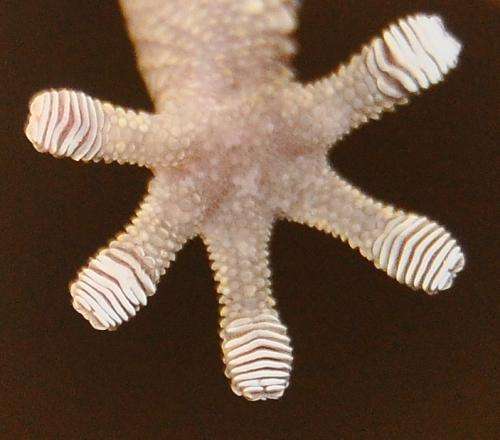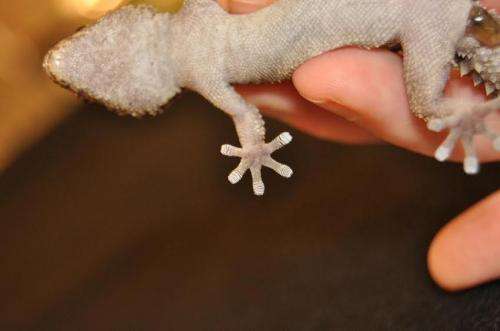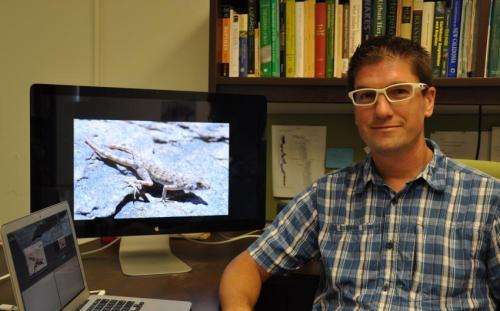What goes up must come down

Found in warm regions of the world, geckos are extremely capable of climbing up steep, smooth surfaces. To do so, they employ an adhesive system – a key evolutionary innovation that facilitates climbing vertically, and even in inverted positions. On the underside of their toes are "setae," millions of very fine hair-like structures, which provide increased surface area and close contact between the foot and the surface on which it rests.
This adhesive system works best when loading – the application of the gecko's weight – occurs along the long-axis of the toe, and when this loading is along the natural curvature of the setae. But can geckos employ this adhesive system when moving downhill? If the setae are positioned so that loading might be against their natural curvature, would the gecko not slip as it moved downhill?
Biologists at the University of California, Riverside have now conducted experiments on geckos in the lab to find the answer. They found that when moving on steep downhill surfaces geckos reverse the position of their hind feet to potentially use the adhesive system as a brake and/or stabilizer, resulting in the digits of the hind feet facing backwards and the setae in the hind feet aligned along the natural curvature of the setae to counteract gravity. Specifically, on a 45 degree downhill slope, the geckos were found to rotate their hind limbs up to 70 degrees more posteriorly (toward the tail).
"This multi-functionality of the gecko adhesive system permits effective locomotion on both uphill and downhill slopes," said Timothy Higham, an assistant professor of biology, in whose lab the research was done. "Without this ability, geckos would be effective at going up, but they would not be able to descend as easily. Indeed, they could plummet downhill."

The research has applications in robotics, specifically in how robots can be designed to move up and down complicated surfaces. Most studies of animal locomotion have been on level terrain. While is it relatively straightforward to predict the demand on an animal going uphill and even get it to move uphill, it is far more difficult to get an animal to move down, Higham said.
"We have a huge amount of uphill locomotion in the literature – the low-hanging fruit, so to speak," he said. "In contrast, there are few downhill locomotion studies. But how animals provide stability to their bodies as they move on non-level terrain – the controlled descent of geckos being just one example – needs to be closely studied."
The research also showed that when geckos move downhill, the forelimbs likely serve as brakes, pressing down on the surface to increase friction; and the hind limbs likely act as stabilizers, akin to the training wheels on a child's bicycle.
"Gecko adhesion is directional," explained Aleksandra V. Birn-Jeffery, the first author of the research paper and a former postdoctoral researcher in Higham's lab. "It doesn't work like Velcro, and there are no suction cups. The adhesion occurs via intermolecular forces and friction (shear force), and it primarily acts along the long axis of the digit. This constrains how the foot must be orientated during locomotion."

Birn-Jeffery and Higham used Chondrodactylus bibronii (gecko) in their experiments because of its varied habitat preference and lack of functional claws. Before it applies the adhesive system, the gecko curls its digits up in the air, then lands the foot on a surface, uncurls the digits, and engages the system. Then, before lifting its foot up again, it curls up its digits.
"They do this to release the adhesive system. Otherwise, it might be difficult to get their feet off the surface, the adhesive system being very strong," Birn-Jeffery said.
Next, the researchers will study geckos in their natural habitat in Namibia and South Africa. Higham is scheduled to visit Namibia in November 2014.
"It is curious that not many people have looked into how geckos move downhill," he said. "We are the first to really figure this out."
Study results appear today (Oct. 14) in Biology Letters, a publication of the Royal Society.
Journal information: Biology Letters
Provided by University of California - Riverside





















